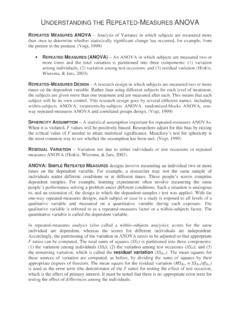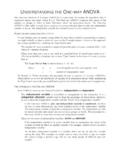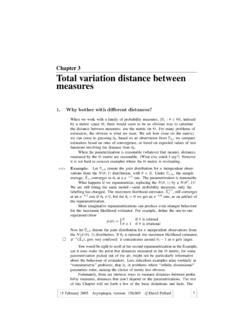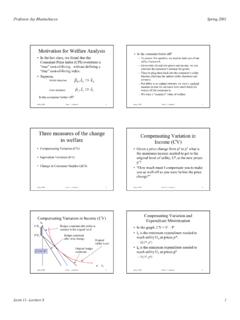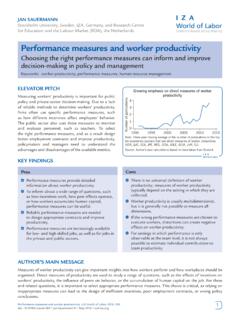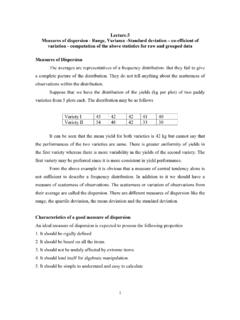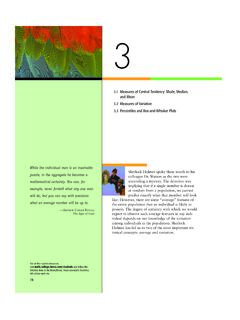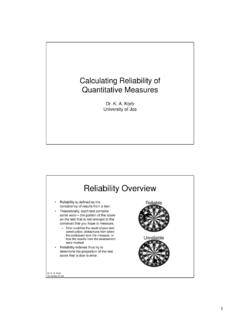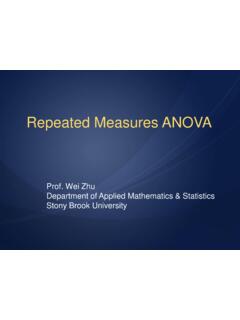Transcription of SPHERICITY IN REPEATED MEASURES ANALYSIS OF VARIANCE
1 SPHERICITY IN REPEATED MEASURES ANALYSIS OF VARIANCE When you conduct an ANALYSIS of VARIANCE with a REPEATED MEASURES factor (within-subjects independent variable), you need to examine the concept of SPHERICITY . This is an assumption of a REPEATED MEASURES ANOVA (RM ANOVA) and violations of this assumption can affect the conclusions drawn from your ANALYSIS . What is SPHERICITY ? Basically, SPHERICITY refers to the equality of the variances of the differences between levels of the REPEATED MEASURES factor. In other words, we calculate the differences between each pair of levels of the REPEATED MEASURES factor and then calculate the VARIANCE of these difference scores.
2 SPHERICITY requires that the variances for each set of difference scores be equal. Put simplistically, we assume that the relationship between pairs of pairs of groups is similar ( , the level of dependence between pairs of groups is roughly equal). We have been taught that it is critical to have homogeneity of VARIANCE between conditions when analyzing data from different participants (such as in a one-way ANOVA), but we are often left to believe that this problem goes away when we use a REPEATED MEASURES design. This however is not the case. The assumption of SPHERICITY can be likened to the assumption of homogeneity of VARIANCE in a between-group ANOVA.
3 SPHERICITY (denoted by and sometimes referred to as circularity) is a more general condition of compound symmetry. Compound symmetry holds true when the variances within conditions are equal (this is the same as the homogeneity of VARIANCE assumption in between-group designs) but also when the covariances between pairs of conditions are roughly equal. As such, we assume that the variation within experimental conditions is fairly similar and that no two conditions are any more dependent than any other two. Although compound symmetry has been shown to be a sufficient condition for conducting ANOVA on REPEATED MEASURES data, it is not a necessary condition.
4 SPHERICITY is a less restrictive form of compound symmetry. SPHERICITY refers to the equality of variances of the differences between treatment levels. If you were to take each pair of treatment levels, and calculate the differences between each pair of scores it is necessary that these differences have equal variances. Assessing SPHERICITY Fortunately, when you conduct a RM ANOVA, SPSS will automatically conduct a test for SPHERICITY the Mauchly s test. The Mauchly s test tests the hypothesis that the variances of the differences between conditions are equal. That is, it tests the assumption (condition) of SPHERICITY .
5 Interpreting this test is straightforward; when the significance level (probability) of the Mauchley s test is less than or equal to the a priori alpha level ( , < .05), we cannot assume SPHERICITY . That is, the assumption of SPHERICITY has not been met (the assumption has been violated). We would therefore conclude that there are significant differences between the VARIANCE of differences. When the significance level (probability) is greater than the a priori alpha level ( , > .05), we can assume SPHERICITY . That is, the assumption of SPHERICITY has been met (the assumption has not been violated).
6 We would then be able to conclude that the VARIANCE differences are not significantly different ( , they are roughly equal). So, in short, if Mauchly s test is significant, then we must be cautious of the F-ratio produced by SPSS. RM ANOVA - SPHERICITY Dealing with violations of SPHERICITY The closer the reported epsilon value is to , the more homogeneous are the variances of differences, and consequently the closer the data are to being spherical. The effect of violating SPHERICITY is a loss of power ( , increased probability of a Type II error) and a test statistic (F-ratio) that simply cannot be compared to tabulated values of the F-distribution.
7 Fortunately, again, when you conduct a RM ANOVA SPSS will automatically generate three corrections for violations of SPHERICITY . These are the Greenhouse-Geisser, the Huynh-Feldt, and the Lower-bound corrections. To correct for SPHERICITY , these corrections alter the degrees of freedom, thereby altering the significance value of the F ratio. There are different options about the best correction to apply the one you choose depends on the extent to which you wish to control for Type I errors. Fuller explanations can be found elsewhere, but a good rule of thumb is to use the Greenhouse-Geisser estimate unless it leads to a different conclusion from the other two.
8 Some researchers have recommended that when epsilon is > .75, the Huynh-Feldt correction should be used, and when epsilon is < .75, the Greenhouse-Geisser correction should be used. There is solid argument for using any of the available correction methods, and as such, the researcher needs to make a decision based on applicable references. Another option when SPHERICITY is violated is to use the multivariate test (which again is provided automatically by SPSS when you ask for a RM ANOVA). However, multivariate tests can be less powerful than their univariate counterparts.
9 In general, the following guideline is useful: when you have a large violation of SPHERICITY (epsilon > .70) and your sample size is greater than (10 + number of levels of the REPEATED MEASURES factor), then multivariate tests are more powerful; in other cases, the univariate test should be preferred. The epsilon value can be found on the Mauchly s test output. It has been reported that when epsilon is greater than .75 (and as high as .90), too many false null hypotheses fail to be rejected ( , the test is too conservative).
